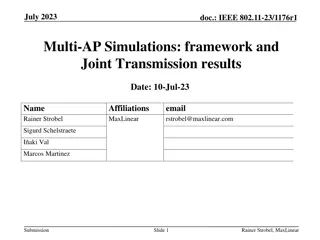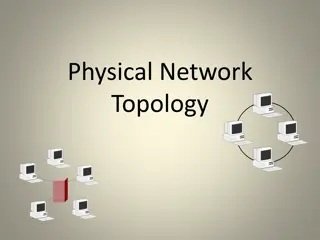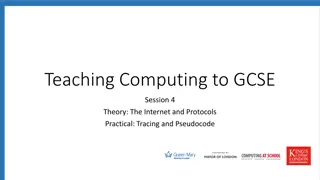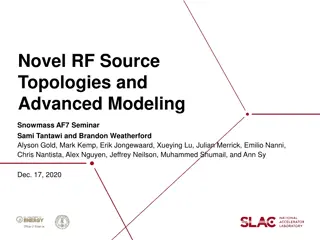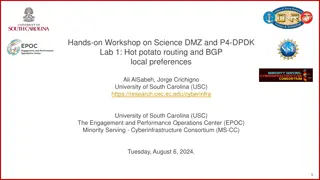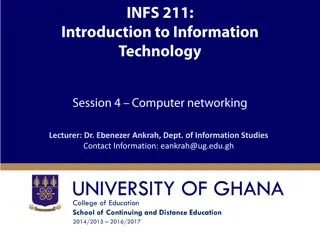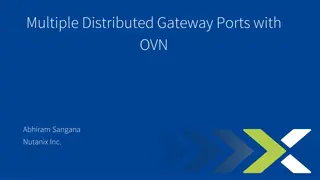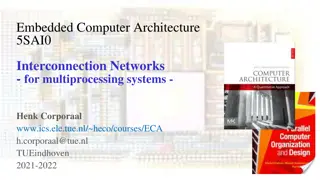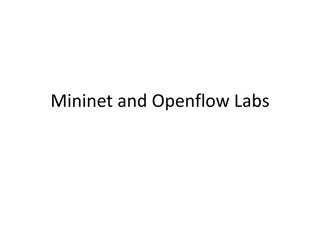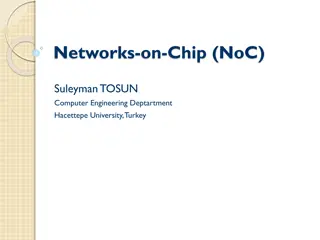Apache MINA: High-performance Network Applications Framework
Apache MINA is a robust framework for building high-performance network applications. With features like non-blocking I/O, event-driven architecture, and enhanced scalability, MINA provides a reliable platform for developing multipurpose infrastructure and networked applications. Its strengths lie i
3 views • 13 slides
Modeling and Generation of Realistic Network Activity Using Non-Negative Matrix Factorization
The GHOST project focuses on the challenges of modeling, analyzing, and generating patterns of network activity. By utilizing Non-Negative Matrix Factorization (NMF), realistic network activity patterns can be created and injected into live wireless networks. Understanding and predicting user behavi
4 views • 28 slides
Automated Anomaly Detection Tool for Network Performance Optimization
Anomaly Detection Tool (ADT) aims to automate the detection of network degradation in a mobile communications network, reducing the time and effort required significantly. By utilizing statistical and machine learning models, ADT can generate anomaly reports efficiently across a large circle network
8 views • 7 slides
Year 8 AP2 Knowledge Organiser - March 2024
This knowledge organiser covers various topics such as data transmission via a network, LAN networks, algorithms, domain names, URL's, computer connections, values comparison, network topologies, WAN concepts, binary conversion, image resolution, sound waves, VOIP, internet vs. WWW differences, data
1 views • 4 slides
Understanding Network Topologies: Bus vs Ring
Explore the world of network topologies with a focus on Bus and Ring configurations. Learn about their features, advantages, and disadvantages, helping you understand the layout and connectivity options in computer networks.
6 views • 80 slides
Understanding Computer Networks: Basics, Components, and Topologies
Computer networks are essential for sharing resources, exchanging files, and enabling electronic communications. This includes components like senders, receivers, messages, transmission media, and various modes of communication. The need for networking arises from file sharing, resource sharing, com
13 views • 28 slides
Revolutionizing Network Management with Intent-Based Networking
Explore the concept and benefits of Intent-Based Networking (IBN) in simplifying network configuration and enhancing efficiency. Learn how IBN automates network operations, aligns with business objectives, improves security, and ensures scalability and reliability. Discover the potential of IBN tool
0 views • 14 slides
Understanding Mesh and Star Network Topologies
Network topology plays a crucial role in network performance and maintenance costs. Mesh topology connects every device with a dedicated link, providing reliability and security. On the other hand, star topology connects devices to a central hub, ensuring communication through the hub. Explore the a
0 views • 22 slides
Network Compression Techniques: Overview and Practical Issues
Various network compression techniques such as network pruning, knowledge distillation, and parameter quantization are discussed in this content. The importance of pruning redundant weights and neurons in over-parameterized networks is highlighted. Practical issues like weight pruning and neuron pru
0 views • 37 slides
Network Slicing with OAI 5G CN Workshop Overview
Overview of Network Slicing with OAI 5G CN workshop focusing on the crucial role of network slicing in realizing the service-oriented 5G vision. This workshop covers topics like multiple logical networks creation on shared infrastructure, different types of network slices, preparation and instantiat
1 views • 6 slides
IEEE 802.11-23/1176r1 Multi-AP Simulations Overview
Detailed exploration of Joint Transmission (JT) simulation results for IEEE 802.11-23/1176r1, emphasizing real-world deployment scenarios in residential settings. The submission discusses topologies, considerations, and initial simulation outcomes, aiming to align with the UHR project goals and opti
0 views • 24 slides
Network Design Challenges and Solutions in Business Data Communications
Issues in designing a Local Area Network (LAN) include needs analysis, technological design, and cost assessment. The traditional approach involves structured systems analysis, but faces challenges due to rapidly changing technology and increasing network traffic. The Building Blocks Approach recomm
1 views • 20 slides
Understanding Feedback Amplifiers: Structure, Properties, and Topologies
Electronic circuits rely heavily on feedback mechanisms, particularly negative feedback, for various purposes such as desensitizing gain, reducing distortion, controlling impedance, and improving amplifier bandwidth. This article explores the general structure of feedback, properties of negative fee
0 views • 68 slides
Understanding Physical Network Topologies
Physical network topology refers to the layout of cables, computers, and peripherals in a network, distinct from logical topology. Common physical topologies include Star, Ring, Linear Bus, Tree, and Mesh. Each topology has its advantages and disadvantages, impacting network performance and reliabil
0 views • 16 slides
Understanding VSAT Technology and Applications
Very Small Aperture Terminal (VSAT) technology revolutionized satellite communications by enabling smaller, more cost-effective earth stations. This article covers the basics of VSAT, its components, advantages, disadvantages, network topologies, and a practical example of its application in KSA. It
1 views • 21 slides
Understanding 5G RAN Network Slicing and Architecture
Explore the intricate world of 5G Radio Access Network (RAN) and Network Slicing, delving into concepts such as SO Service Orchestrator, SDN-C Service Design, and Core Network Elements. Discover the significance of managing and designing mobile slice services, including eMBB, Massive IoT, and Missio
0 views • 26 slides
Understanding Snort: An Open-Source Network Intrusion Detection System
Snort is an open-source Network Intrusion Detection System (NIDS) developed by Cisco, capable of analyzing network packets to identify suspicious activities. It can function as a packet sniffer, packet logger, or a full-fledged intrusion prevention system. By monitoring and matching network activity
0 views • 23 slides
Data Flows and Network Challenges in Particle Physics Infrastructure
This overview delves into the data flows and network challenges faced in particle physics infrastructure, focusing on the JUNO project. It discusses the process of data reception, storage, and replication across various data centers, highlighting the bidirectional nature of data flows. Additionally,
0 views • 24 slides
Transportation Network Modeling and Analysis with C.Coupled SE Platform
This content outlines the features and functionalities of the C.Coupled SE Platform (CSET Platform) developed by the Connetics Transportation Group. It covers aspects such as interface design, inputs merging, purposes, platform development using Cube, TAZs merging, and network attributes. The platfo
0 views • 11 slides
Novel Control Methods of DC-DC Converters in Electrical Engineering
Introduction to a novel control method of DC-DC converters in electrical engineering focusing on various converter topologies, closed-loop control techniques, performance comparison of controllers, and drawbacks with modifications. The presentation covers essential aspects such as regulation, conver
0 views • 51 slides
Understanding Token Ring Technology in Computer Networks
Token Ring, developed by IBM, is a networking technology that uses a token passing scheme for data transmission. Devices on the network take turns transmitting data by holding a token and releasing it after data transfer. Unlike Ethernet, Token Ring offers unique benefits and operates efficiently in
2 views • 17 slides
Comprehensive Overview of Computer Networks and Protocols for GCSE Level
Explore the diverse aspects of computer networks and protocols through in-depth discussions on LAN, WAN, client-server relationships, hardware requirements, network topologies, protocols like TCP/IP and HTTP, and the significance of network layers. Understand the roles, benefits, and risks associate
0 views • 23 slides
Innovations in RF Source Topologies and Modeling for Enhanced Efficiency
Explore novel RF source topologies and advanced modeling techniques to achieve higher efficiency and power density in RF systems. Discover tradeoffs, multi-beam arrays, radial beam klystrons, and deflected beam amplifiers for improved performance in high-power applications.
0 views • 15 slides
Meridian: An SDN Platform for Cloud Network Services
Meridian is an SDN platform developed by Mohammad Banikazemi, David Olshefski, Anees Shaikh, John Tracey, and GuohuiWang at IBM T. J. Watson Research Center. The platform focuses on providing cloud network services efficiently. It encompasses an architecture that enables faster and more convenient n
0 views • 21 slides
Enhancements for Off-Channel Peer-to-peer Communications in IEEE 802.11-24/393r3
This contribution discusses enhancements for Off-Channel Peer-to-peer (P2P) communications in IEEE 802.11-24/393r3, building upon prior work in this area. It explores the concept of recommended P2P channels and how APs can incentivize P2P STAs to use these channels for better communication quality.
0 views • 12 slides
Hands-On Workshop on Science DMZ and P4-DPDK Lab
Join the workshop at the University of South Carolina to learn about hot potato routing, BGP local preferences, and hands-on lab activities focusing on network topologies and configurations. Explore the Lab Topology, Lab Configuration, and Platform Information for an interactive learning experience
0 views • 6 slides
Understanding Local Area Networks: Basics, Advantages, and Disadvantages
A Local Area Network (LAN) serves various functions such as file serving, print serving, video transfers, and more. LANs offer advantages like resource sharing, private ownership, and secure transfers, but come with disadvantages such as costliness and maintenance issues. Different LAN topologies li
0 views • 50 slides
Octavia Project Overview and Updates
Octavia is a network load balancing service in OpenStack that provides scalable, on-demand, and self-service access to load balancer services. The project has evolved to encompass all network load balancing and offers key features such as flexible network topologies, highly available load balancers,
0 views • 11 slides
Understanding Network Analysis: Whole Networks vs. Ego Networks
Explore the differences between Whole Networks and Ego Networks in social network analysis. Whole Networks provide comprehensive information about all nodes and links, enabling the computation of network-level statistics. On the other hand, Ego Networks focus on a sample of nodes, limiting the abili
0 views • 31 slides
Understanding Computer Networks in Education: A Session Overview
Explore the world of computer networks with Dr. Ebenezer Ankrah from the Dept. of Information Studies. Discover network categories, types, topologies, bandwidth, and more. Gain insights on server-based vs. peer-to-peer networks and key network concepts. Dive into essential topics covered in the sess
0 views • 33 slides
Advanced Networking with Multiple Distributed Gateway Ports in OVN
Explores the latest advancements in networking technology with OVN by allowing the creation of multiple Distributed Gateway Ports per logical router. This feature enables connectivity to multiple external networks, supporting scenarios like shared services, NAT configurations, and load balancing. Di
0 views • 7 slides
Understanding the Impact of Crooked Traceroute on Network Topologies
Traceroute-based algorithms play a crucial role in collecting network topology data, but the introduction of per-flow load balancing has raised concerns about the accuracy of these algorithms. This study examines the implications of crooked traceroute on false link inference rates and the identifica
0 views • 23 slides
Interconnection Networks in Multiprocessing Systems Overview
Explore the intricacies of interconnection networks for multiprocessing systems in Embedded Computer Architecture, covering connecting processors, topologies, routing, deadlock, switching, and performance metrics like bandwidth and latency. Delve into various network types, such as on-chip networks
0 views • 33 slides
Networking Labs with Mininet and OpenFlow
Explore networking labs with Mininet and OpenFlow, covering topics such as installation, configuration, walkthroughs, and manual setup of OpenFlow switches using dpctl. Learn to create topologies, modify network parameters, and write Python scripts for custom setups. Dive into understanding OpenFlow
0 views • 14 slides
Network Function Virtualization (NFV) Overview
Network Function Virtualization (NFV) focuses on virtualizing network functions to improve efficiency and reduce costs in network infrastructure. The lecture discusses key readings, devices that compose a network, specialization of devices, benefits of one-device-does-anything approach, and the goal
0 views • 21 slides
Enhancing Network Stability with Network Monitoring Systems
Network monitoring is crucial for efficient management and proactive issue detection in a network environment. Factors influencing an effective network system include choosing the best OEM, SLA agreements, and selecting a reliable System Integrator. Reactive monitoring can lead to financial losses a
0 views • 12 slides
Understanding Network Security Part 2: Link Layer and ARP
Exploring the vulnerabilities in simple network topologies with hubs and the need for examining the link layer to prevent eavesdropping. Dive into MAC addresses, ARP (Address Resolution Protocol), and how machines translate IP addresses to physical Ethernet addresses. Learn about ARP tables, the tra
0 views • 61 slides
Understanding Networks-on-Chip (NoC) in Computer Engineering
Networks-on-Chip (NoC) represent a packet-switched communication network designed for on-chip systems, allowing efficient data routing via switches and interconnection links. NoCs aim to apply large-scale network concepts in embedded systems, offering scalability, flexible QoS guarantees, higher ban
0 views • 29 slides
Cost-Effective and Survivable Cabling Design under Major Disasters
Submarine fiber-optic cables play a crucial role in global communication, with an extensive network spanning thousands of miles. This study focuses on optimizing cabling design to enhance survivability during major disasters like earthquakes. By considering various network topologies and laying stra
0 views • 35 slides
Understanding Interconnection Networks in Embedded Computer Architecture
Explore the intricacies of interconnection networks in embedded computer architecture, covering topics such as connecting multiple processors, topologies, routing, deadlock, switching, and performance considerations. Learn about parallel computer systems, cache interconnections, network-on-chip, sha
0 views • 43 slides










